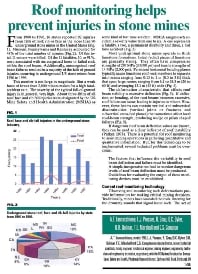Mining Publication: Roof Monitoring Helps Prevent Injuries in Stone Mines
Original creation date: November 2000
Authors: AT Iannacchione, LJ Prosser, RH Grau, DC Oyler, DR Dolinar, TE Marshall, CS Compton
From 1900 to 1996, 16 states reported 92 injuries from falls of roof, rib or face in the more than 90 underground stone mines in the United States. Missouri, Pennsylvania and Kentucky accounted for 48% of the total number of injuries. Of this total, 11 miners were killed. Of the 11 fatalities, 10, or 91%, were associated with unrecognized loose or failed rock within the roof beam. Additionally, unrecognized roof beam failures resulted in a majority of the falls of ground injuries occurring in underground U.S. stone mines from 1990 to 1996. This number is not large in magnitude. But a workforce of fewer than 2,000 miners makes for a high fatality accident rate. The severity of the typical fall-of-ground injury is, in general very high. About three-fifths of all roof, face and rib fall injuries were designated by the US Mine Safety and Health Administration (MSHA) as some kind of lost time accident. MSHA assigns each accident a severity value from one to six. A one represents a fatality, a two, a permanent disability and three, a lost time accident (Fig. 3). Most underground stone mines operate in thick limestone formations. Intact (solid) pieces of limestone are generally strong. They often have compressive strengths of 207 MPa (30.000 psi) and tensile strengths of 14 MPa (2.000 psi). Persistent horizontal bedding planes typically cause limestone roof rock members to separate into beams ranging from 0.15 to 1 m (0.5 to 3 ft) thick that span large rooms, ranging from 6.1 to 18.3 m (20 to 60 ft) and averaging 13.1 m (43 ft) wide (Fig. 4). The deformation characteristics that affects roof beam stability is excessive deflection (Fig. 5). If deflection, or bending, of the roof beams becomes excessive roof failure can occur, leading to injuries to miners. However, these beams can contain vertical and sub vertical discontinuities (vertical joints or fractures and sub vertical cross-bed planes) that sometime affect local roof-beam strength, producing wedge or prism shaped failures (Fig. 5). If dangerous roof beam deflection values are known they can be used as a clear indicator of roof instability (Parker. 1973). There is a potential for roof monitoring to assist mining operations in gathering quantitative and qualitative information. But, for this technology to be implemented several technical problems must be overcome: The factors that influence the variability in roof beam deflection and failures must be identified. A simple inexpensive method to monitor dangerous levels of roof beam deflection must be produced. Guidelines for evaluating the output of these monitoring devices must be established.
